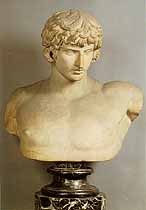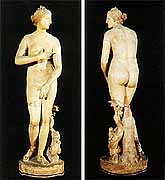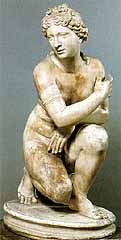
Roman copy, young boy
taking a thorn from his foot
Excusez nous mais cette page n'est pas été encore traduite en Français
The collection of classical sculpture in the Uffizi Gallery is of considerable artistic and historic interest and extraordinary spectacular value. Most of these antique marbles, which were studied by generations and generations of Tuscan sculptors, are placed along the three corridors of the Gallery (not surprisingly, it was also known as the "Gallery of Statues" for many years): the second, shorter corridor in particular contains the Young boy taking a thorn from his foot, the bust of Antinous and the Bathing Venus. Other antiquities are exhibited in the Archeological Room, in the Room of Niobe and in the Tribune, which contains some of the most famous works and also leads into the Room of the Hermaphrodite. Most people already know that Lorenzo the Magnificent had created a large collection of ancient marbles in the gardens of St. Mark, which were to be fundamental for the didactic experience of young artists like Michelangelo. During the 16th century Grand Duke Cosimo I and his son Francesco I managed to retrieve and reunite what little was left of these early Medici collections after being plundered in 1494, and place them in the Pitti Palace, Palazzo Vecchio and the Uffizi Gallery. This was also the period in which excavations were being carried out all over the grand-ducal territories and which resulted in the discovery of Etruscan works of art like the Chimera, the Arringatore and the Minerva, now in the Archeological Museum.

Roman
art, bust of Antinous
However it was thanks to Cardinal and later Grand Duke Ferdinando I, resident in Rome until 1587 (the year in which he succeeded to the throne of his brother Francesco I, who died without male heirs), that the collection was enriched with some of the finer antique scultures, most of them carried out in traditional Hellenistic style: the famous Medici Venus (1st century B.C., copy of the original by Praxiteles of the 4th-3rd century B.C. and possibly from Villa Adriana at Tivoli), the Scythian known as the Knife-Grinder (found in Rome in around 1519), the Wrestlers, Dionisius and the Satyr (excavated near the Porta Maggiore in around 1550) and the mid-Hellenistic group of 12 statues of the Niobe and the Niobids (the decoration of the pediment from a temple, found near San Giovanni in Laterano in 1583).

Hellinist copy, Medici Venus
Even so, Ferdinando I, who also bought up the Valle Capranica collection in bulk (1584), left most of the statues in the Medici villa in Rome (situated on the Pincio and purchased in 1576) where he had lived up until the death of his brother; the sculptures in fact were not removed from there until some time later: first in 1677 (when Cosimo III had the Medici Venus and the Hermaphrodite brought to Florence) and later, between 1778 and 1787, during the period in which the laical tendencies of the Lorraine rule and the new passion for archeology were becoming increasingly popular. Grand Duke Pietro Leopoldo commissioned (1780-81) architect Gaspare Maria Paoletti to prepare a new salon in the West Corridor of the Gallery to exhibit the Group of the Niobids (and naturally called the Room of Niobe), richly decorated with gold and white stucco work, and where the 12 statues can still be found today.

Roman
copy, dancing Faun
Apart from the Niobids, other important classical sculptures in the collection, most of them Roman, or Roman copies of Greek originals, include a copy (in marble and basalt) of the Doryphorus by Polyclitus (Archeological Room), a replica of the Ares of Alcamene, statues of Aesculapius and of Demeter, the Medici Venus, the Knife Grinder and the Wrestlers (the latter three in the Tribune), the Farnese Heracles, the two statues of Marsyas, the Boy taking a thorn from his foot (second corridor), the bust of the dying Alexander.

Roman copy, Venus
There are moreover portraits of Octavianus, Agrippa Minor, Trajan, Antoninus Pius, Lucius Verus, Marcus Aurelius, Caracalla and Severus Alexander. The reliefs include the neoclassical Crater with a figured frieze and the sarcophagi decorated with the Rape of Proserpine and the story of Phaedra and Hippolytus.

The copy of the Laocoon (discovered in Rome in 1506) carried out in marble by Baccio Bandinelli is also particularly interesting because this ancient sculpture was to be one of Michelangelo's sources of inspiration for his Doni Tondo.

